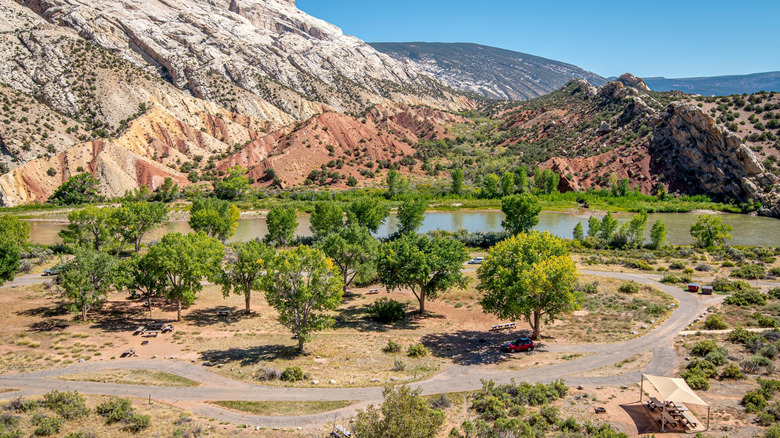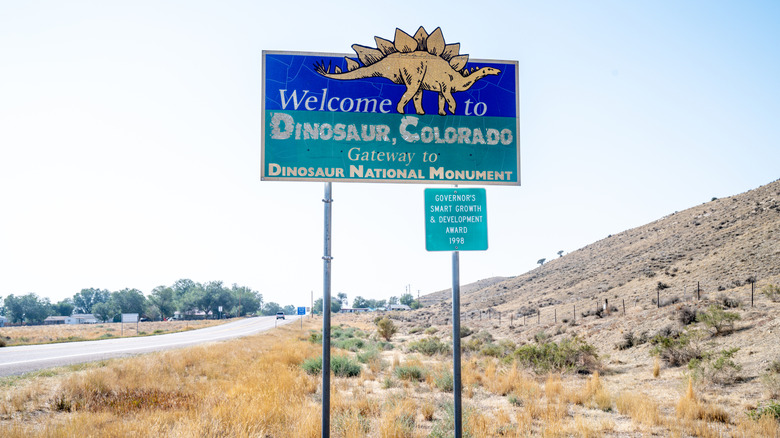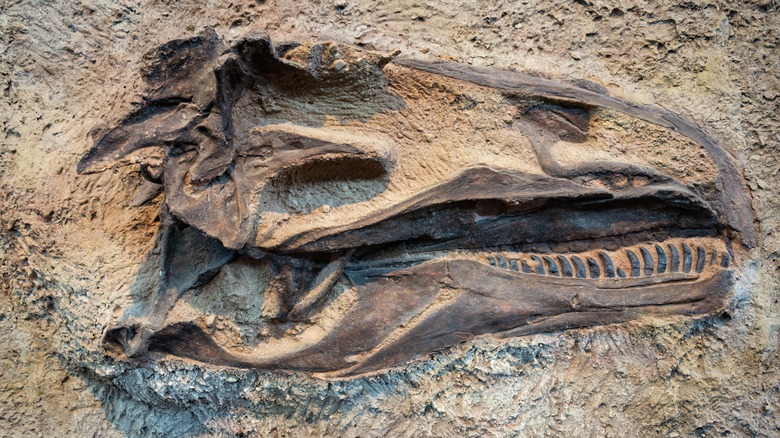The 'Cannabis Capital Of Colorado' Is A Uniquely Dinosaur-Centric Town Full Of Endless Outdoor Adventures
Colorado, today known for its sky-high mountains, numerous ski slopes, local breweries, year-round camping, and more recently, legalized marijuana, was once a paradise for dinosaurs, mammoths, and ancient sharks. Nowhere is that more apparent than in Dinosaur, Colorado. A town renamed for, and adorned by, the giant beasts found in the ground nearby, is also flocked to for the plants that grow above it.
Considered by some to be the "Cannabis Capital of Colorado," Dinosaur's narrow borders are home to four different marijuana dispensaries and just a handful of other businesses. With cannabis being the town's primary economic driver, and its proximity to Utah and Wyoming, both states where recreational marijuana use is illegal, the nickname stuck. Also serving as the gateway to Dinosaur National Monument, this Colorado town is a prime destination for hikers, climbers, and those who enjoy underrated scenic drives through state parks and towering canyons.
Relatively isolated and just a few miles from the Utah/Colorado border, visitors must fly then drive to Dinosaur. Salt Lake City International Airport, roughly 3 hours away by car, offers the most airline and fare options. For fewer options, but less time in the car, fly into Grand Junction Regional Airport, then drive approximately 2 hours along the aptly named Dinosaur Diamond, one of Colorado's many scenic byways. While small, with a population of fewer than 250 and a land area of less than 1 square mile, Dinosaur has more than its fair share of ancient history, marijuana dispensaries, and recreational activities.
Trails, dispensaries, and fossils in and near Dinosaur
Of the seven states that border Colorado (eight, if you're including Texas, which has a mere 34 miles separating it from Colorado via the Oklahoma panhandle), just New Mexico and Arizona allow the legal sale of marijuana for adult recreational use. This makes Dinosaur, with its prime location in the middle of a legalization desert, so to speak, the ideal stopover for nearby marijuana consumers. While in Dinosaur, whether you're a cannabis connoisseur or just interested in learning about the plant's impact and evolution, stop by the Rocky Mountain Cannabis dispensary, appropriately located at 420 Brontosaurus Blvd. For a quick bite of freshly made dino-themed sandwiches, grab lunch at Bedrock Depot, open Friday through Tuesday, or, for more traditional American fare like burgers and hot dogs, try Highway Bar & Grill, open Wednesday through Sunday.
As mentioned, Dinosaur is an incredibly small town, so visitors should explore the entire area around it. For outdoor adventurers, hop in the car to explore the many trails and canyons near Dinosaur, including Harper's Corner Scenic Drive and Trail, and Echo Park/Sand Canyon Trail. Just 2 miles west of town, enter Dinosaur National Monument via the Canyon Visitor Center. Situated in the Uinta Mountains, a subrange of the Rocky Mountains, the monument has plenty of hiking trails, campgrounds, and picnic areas. Experienced backpackers can also take advantage of the many backcountry camping opportunities. Fishing, horseback riding, and biking are all permitted within Dinosaur National Monument.
For history buffs, search for more than 1,000 ancient petroglyphs and pictographs, or join a ranger to see dinosaur remains in the park's red rock formations. To round out your adventure, drive 30 minutes to the Dinosaur Quarry Exhibit Hall, nestled in the beautiful mountains on the Utah side of the Dinosaur National Monument, to view more than 1,500 dinosaur fossils.
Dinosaur, Colorado: 200 million years in the making
Long before Colorado's human residents legalized marijuana, dinosaurs and other prehistoric animals were the primary inhabitants of the region, evidence of which can be found throughout the Centennial State and on the Utah side of Dinosaur National Monument. The state's unique geology and climate, formed millennia ago, created the perfect environment for prehistoric life. Once covered by a shallow sea teeming with prehistoric sharks, turtles, and marine invertebrates, as its waters receded, the area soon became home to more well-known dinosaurs like Stegosaurus (the Colorado state fossil), Triceratops, Allosaurus, and perhaps most infamous of all, Tyrannosaurus Rex.
In the millions of years since, the area fluctuated between wetlands, sea, and rainforests. These environments were ideal for preserving the bones, footprints, and in some cases, even cartilage, of the ancient flora and fauna that once dominated the state's massive grounds. The Rocky Mountains began forming roughly 75 million years ago, and it's through their initial uplift and the millennia of geologic activity that followed that the thousands upon thousands of Colorado's fossils were so perfectly preserved. Once you've seen all the prehistoric beasts who found their final resting place in Dinosaur National Monument, drive to Grand Junction, known for its astonishing views, breathtaking trails and mini-Grand Canyon, or east across the Rocky Mountains to Morrison, Canon City, and Woodland Park, to view more of the state's 60,000-plus fossils.


